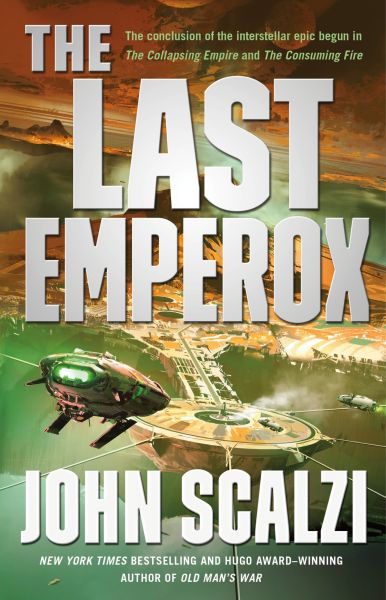The End of Everthing That Stands
The Last Emperox (The Interdependency, volume 3)
By John Scalzi

22 Feb, 2021
0 comments
2020’s The Last Emperox is the third and final volume in John Scalzi’s The Interdependency trilogy. Three books to a trilogy is a visionary step other authors would do well to emulate.
The Interdependency: still doomed by the impending collapse of the Flow, on which all interstellar trade depends! Emperox Grayland II: still determined to save the Interdependency’s people! The entire Nohamapetan family, with the exception of the late Amit Nohamapetan (still dead!): still an enormous pain in the ass.
The Interdependency has a parliament. Unfortunately, the core mission of the Interdependency for the last thousand years has been “enrich the oligarchs without making the masses so desperate that they rise up in anger,” not “solve existential crises in a timely fashion.” Look not to parliament for a constructive response to the crisis.
There is a single world in the entire forty-seven-system empire that has a habitable world: End. Even if a civilization-ending crash follows the collapse of the Flow, End may well avoid the worst effects of the calamity. Therefore, anyone who can get to End will be trying to get to End. The alternative is lingering death.
While moving everyone to End might seem like the go-to strategy, there are a couple of significant impediments. Firstly, despite being a space-based culture, the Interdependency does not have the means to move more than a small fraction of its entire population to End. Secondly, said population numbers more than twenty billion people1, whereas End currently supports fewer than a hundred million people. Even if the Interdependency could get everyone to End, End’s infrastructure would collapse.
There is reason for hope. Marce Claremont’s Flow model is known to be incomplete. Grayland II is in possession of data that could greatly improve Marce’s model and perhaps, point the way to saving a larger fraction of the population. This would require Grayland II to admit that the state kept important, need-to-know information from Marce. Since Marce is Grayland II’s lover, the resulting conversation could only be awkward.
It may not matter. Nadashe Nohamapetan is free. Worse, Nadashe has allies. Nadashe has a grand vision of the future that involves Nadashe as Emperox. For that to happen, Grayland II must die.
~oOo~
The Poul Anderson Memorial Extended Exposition Under Stress Award goes to Nadashe’s brother Ghreni, who provides a lengthy discourse on the entire backstory that a reader new to the series needs to know. He does this while being slammed around in a tumbling aircraft that has just been shot out of the air.
One is tempted to review while keeping in mind the book that one wanted to read; that way lies anger at the actually existing book for failing to resemble the book one has imagined. In the case of The Last Emperox, the book I wanted to read was the Apollo-13-esque story of how the masses were saved through creative use of available resources. This is not that book. On reflection, nobody promised me that book.
The book Scalzi actually wrote is about the political impediments to finding and implementing said solution, which is that the family-run monopolies that own the Interdependency have a thousand years practice of not giving a fuck about the little people2. Whereas for Grayland II, the Interdependency is its people, for people like noted hate-sink Nadashe, it is the social structure and the people at the top. Everyone else is expendable.
Politically, the novel sends a bit of a mixed message. On the one hand, almost all of the monopolistic oligarchs who run things are self-centered obligate schemers incapable of seeing other people as anything more than expendable resources. On the other, the path to victory depends on Grayland II’s autocratic powers; she has resources that are far more extensive than the legions opposing her suspect. SF does love stories about power that is highly centralized in the Right Hands.
Even granting Grayland II’s resources, the novel’s path towards a satisfying resolution seems to depend on hitting the right emotional notes in the right order; when I stopped and thought about it, it didn’t seem entirely logical. But then, in these sad and desperate times, “does this make sense” no longer has the weight it did five years ago. I am reminded of Leverage3.
This book wasn’t quite what I wanted, but the transport trucks pouring currency into the Scalzi living room suggest that these energetic adventures please someone. Maybe you’re one of those people!
The Last Emperox is available here (Amazon US), here (Amazon Canada), here (Amazon UK), here (Barnes & Noble), here (Book Depository), and here (Chapters-Indigo).
1: Admission of error: I thought the Interdependency was crap at science because it is limited by a small population. No, it turns out it has lots of people. It’s crap at science because of its institutional power structures.
2: To be fair, the Interdependency kept all its balls in the air for a thousand years without even significant dynastic churn, which most nations and empire don’t manage.
3: Leverage was a TV show about con artists using their talents to punish the rich and powerful. According to the showrunner, 30 percent of the audience could not understand the cons. That did not seem to matter as long as the show hit the right emotional notes in the right order.
